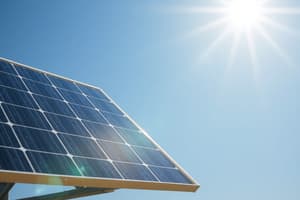Podcast
Questions and Answers
What is meant by thermal equilibrium?
What is meant by thermal equilibrium?
- The state where there is no heat transfer between the systems. (correct)
- The state where there is continuous heat transfer between the systems.
- The state where the temperature of both systems is decreasing.
- The state where the temperature of both systems is increasing.
What is the specific heat capacity of water?
What is the specific heat capacity of water?
- 4180 J/kg ºC (correct)
- 2250 J/kg ºC
- 390 J/kg ºC
- 1000 J/kg ºC
What is the term for the energy required to change the state of a substance from liquid to gas?
What is the term for the energy required to change the state of a substance from liquid to gas?
- Thermal Radiation
- Latent Heat of Fusion
- Latent Heat of Vaporisation (correct)
- Specific Heat Capacity
What is the purpose of the equation: (𝑇#$ x (𝑚% 𝑐% + 𝑚!" 𝑐!" )) − 𝑚% 𝑐% 𝑇% = 𝑇!" / 𝑚!" 𝑐!" ?
What is the purpose of the equation: (𝑇#$ x (𝑚% 𝑐% + 𝑚!" 𝑐!" )) − 𝑚% 𝑐% 𝑇% = 𝑇!" / 𝑚!" 𝑐!" ?
What is the energy used to produce steam when the copper is transferred to the water?
What is the energy used to produce steam when the copper is transferred to the water?
What is the missing piece of data needed to calculate the energy used to produce steam?
What is the missing piece of data needed to calculate the energy used to produce steam?
What is the term used to describe the process of heat transfer illustrated in the diagram?
What is the term used to describe the process of heat transfer illustrated in the diagram?
Which material has the greatest increase in temperature when 3.6 x 10^6 J of heat is transferred?
Which material has the greatest increase in temperature when 3.6 x 10^6 J of heat is transferred?
What happens to the thermal energy of R-134a when it is pressurised inside the compressor?
What happens to the thermal energy of R-134a when it is pressurised inside the compressor?
What is the function of latent heat in a phase change?
What is the function of latent heat in a phase change?
What is the process of heat transfer by conduction?
What is the process of heat transfer by conduction?
Why is the temperature of a substance constant during a phase change?
Why is the temperature of a substance constant during a phase change?
What is the term used to describe the transition from gas to liquid?
What is the term used to describe the transition from gas to liquid?
What happens to the motion of R-134a molecules when heat is transferred to the outside air?
What happens to the motion of R-134a molecules when heat is transferred to the outside air?
What is the primary method of heat transfer responsible for the emission of thermal radiation from the skin of a giraffe?
What is the primary method of heat transfer responsible for the emission of thermal radiation from the skin of a giraffe?
What is the purpose of the carotid rete in a giraffe's cooling system?
What is the purpose of the carotid rete in a giraffe's cooling system?
What is the latent heat of vaporisation?
What is the latent heat of vaporisation?
What is the purpose of the evaporator in the refrigerator?
What is the purpose of the evaporator in the refrigerator?
What is the primary function of expansion joints in bridges?
What is the primary function of expansion joints in bridges?
What is the effect of evaporation on the temperature of a substance?
What is the effect of evaporation on the temperature of a substance?
What is the unit of specific heat capacity?
What is the unit of specific heat capacity?
What is the purpose of the blood vessels beneath the skin of a giraffe?
What is the purpose of the blood vessels beneath the skin of a giraffe?
Flashcards are hidden until you start studying
Study Notes
Heat Transfer
- Heat transfer can occur through conduction, radiation, and convection.
- Conduction is the transfer of heat between objects in physical contact.
- Radiation is the transfer of heat through electromagnetic waves.
- Convection is the transfer of heat through the movement of fluids.
Solar Heating and Air Movement
- Solar heating causes air to expand and rise, creating an area of low pressure near the surface.
- This leads to the movement of air from high-pressure areas to low-pressure areas.
Specific Heat Capacity
- The specific heat capacity of a material is the amount of heat energy required to change the temperature of 1 kg of the material by 1°C.
- The specific heat capacity of concrete is 880 J/kg°C.
- The specific heat capacity of grass is 800 J/kg°C.
Refrigeration
- The refrigeration process involves the compression of a gas, which increases its temperature.
- The pressurized gas is then forced into coils, where it transfers heat to the outside air through conduction.
- The phase of the gas changes from gas to liquid as heat is transferred to the outside air.
- The term used to describe the transition from gas to liquid is condensation.
Latent Heat of Vaporisation
- The latent heat of vaporisation is the energy required to change the phase of a substance from liquid to gas.
- The latent heat of vaporisation of R-134a is 2.17 x 10^5 J/kg.
Coefficient of Volume Expansion
- The coefficient of volume expansion of a material is the change in volume per unit change in temperature.
- The coefficient of volume expansion of R-134a is 3.24 x 10^-3 °C^-1.
Giraffe Adaptations
- Giraffes have adaptations to help them survive in the desert, such as networks of blood vessels that bring warm blood to the skin.
- Heat is transferred from the blood to the skin through thermal radiation.
- Evaporation of water on the skin cools the blood beneath the skin.
Bridges and Expansion Joints
- Expansion joints on bridges allow for the expansion and contraction of the bridge material with changes in temperature.
- The coefficient of linear expansion of steel is 12 x 10^-6 °C^-1.
Temperature Measurement
- Thermal equilibrium is the state in which the temperatures of two or more systems are equal.
- The specific heat capacity of water is 4180 J/kg°C.
- The specific heat capacity of copper is 390 J/kg°C.
Latent Heat of Vaporisation and Steam
- The latent heat of vaporisation of steam is 2.25 x 10^6 J/kg.
- The energy used to produce steam can be calculated by measuring the mass of steam produced and the temperature of the steam.
Studying That Suits You
Use AI to generate personalized quizzes and flashcards to suit your learning preferences.




